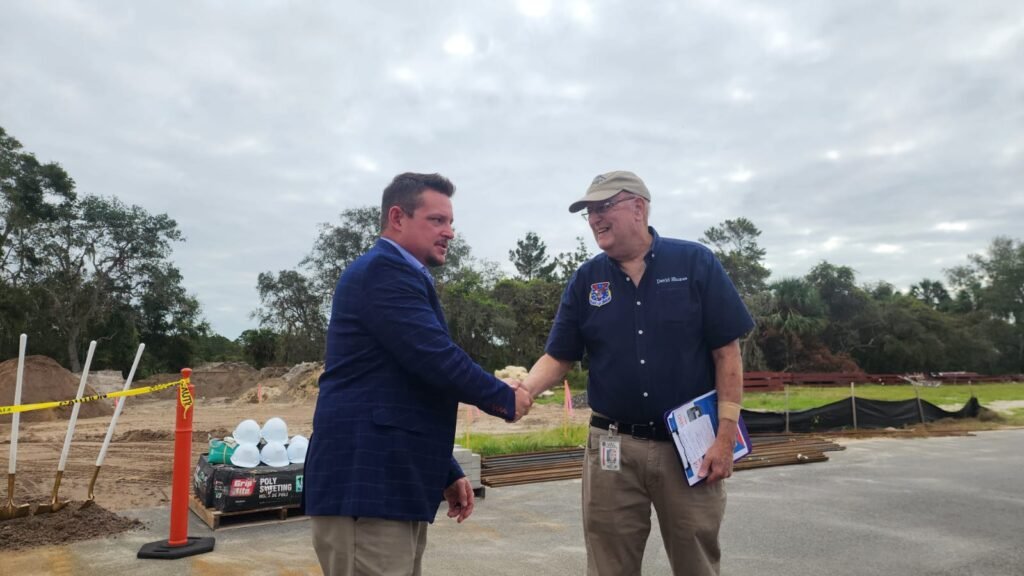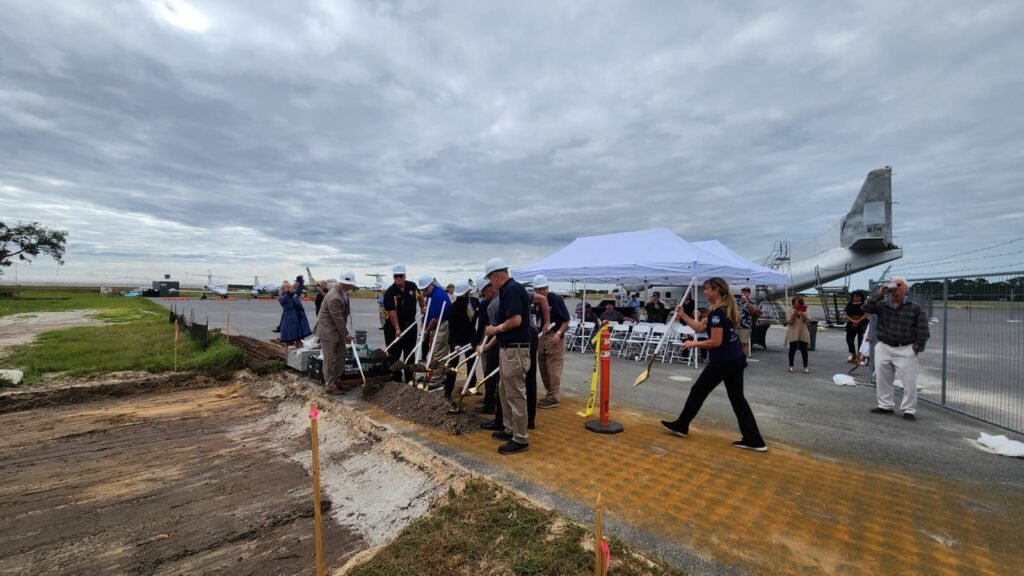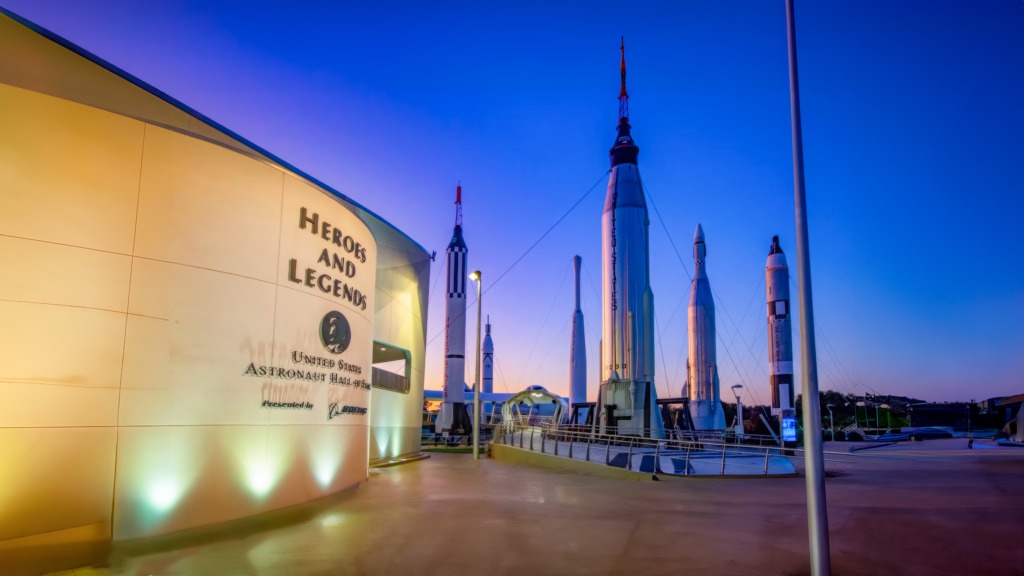Titusville, Fla. – In the shadow of vintage warplanes, local officials thrust their shovels into Florida’s sandy soil on a bright Monday morning, November 18, 2024. The ceremony, held at the Valiant Air Command Warbird Museum, marked the groundbreaking of a multi-use hangar that promises to propel this quiet Space Coast city into the new space age. Surrounded by the museum’s collection of WWII-era aircraft, the moment symbolized a bridge between Titusville’s aviation legacy and its future in the commercial aerospace economy.
Mayor Daniel Diesel stood alongside Commander Bob Boswell of the Warbird Museum, both men beaming at the crowd of space industry enthusiasts and longtime residents gathered for the occasion. Flanking them were Titusville-Cocoa Airport Authority representatives – David L. Shores and Justin Hopman, – who have helped shepherd the project from idea to reality. “I’m so proud to see this vision become reality,” Mayor Diesel said, invoking the city’s hopes that the project will usher in a renaissance of high-tech jobs and innovation. Moments later, their ceremonial shovels bit into the earth, cheered on by a community eager to reclaim a leading role in aerospace.
The new hangar is far more than a storage shelter for aircraft. When completed in late 2025, the state-of-the-art facility will support the development, testing, and housing of space-capable vehicles, effectively solidifying Space Coast Regional Airport’s status as an official spaceport for horizontal launch operations. (Unlike traditional vertical rocket launches, horizontal launch operations involve winged spacecraft or air-launched vehicles taking off from a runway.) The 15,000-square-foot structure is designed to accommodate next-generation spacecraft and their support equipment, providing a versatile base for companies building and launching orbital and suborbital vehicles. Airport deputy director Justin Hopman noted that its design will allow flexible use: one day the hangar might host a sleek spaceplane or satellite-packed aircraft, and the next it could welcome an aerospace expo or educational event. Such multi-purpose utility means the hangar can generate revenue and buzz even between launches, anchoring a broader aerospace campus on the museum’s grounds.
Titusville’s push into the commercial space industry is as strategic as it is symbolic. The city sits just west of Kennedy Space Center and Cape Canaveral, historic launch sites that earned the region its “Space Coast” moniker decades ago. But until recently, Titusville’s airport played only a peripheral role in spaceflight. That is changing with the airport authority’s concerted efforts to attract space startups and established aerospace firms to the area. “This cutting-edge facility will support spacecraft production, development, and storage while solidifying the airport’s role as a licensed spaceport for horizontal launch operations,” the Airport Authority explained in a statement, highlighting the hangar’s importance for bringing new space business to town. Local leaders envision companies using the facility to assemble and test space-bound vehicles — from winged micro-launchers to high-altitude balloons — taking advantage of the airport’s long runways and proximity to industry talent. The hope is that the hangar becomes a magnet for aerospace investment, creating high-paying jobs for engineers, technicians, and support staff, and inspiring spin-off businesses in the area.
Titusville’s ambitions echo a broader trend unfolding across the country as regional airports and communities race to stake their claim in the booming space economy. In recent years, new commercial spaceports have been popping up from Alaska to Virginia, driven by both public agencies and private enterprises. Industry observers note that while dramatic rocket launches still grab the headlines, much of the unsung heavy lifting happens on the ground at facilities like Titusville’s. As a CNBC report described, “spaceports are quietly driving the industry forward, acting as its critical backbone,” even if the “enduring sex appeal of thundering rocket launches” tends to steal the spotlight. The Federal Aviation Administration has already licensed ten such spaceports nationwide, and “another half-dozen locations are knocking on the door,” eager to host launch companies and cash in on the space boom. This national spaceport boom provides context – and a touch of competition – for Titusville’s venture. The city is not just building a hangar; it’s entering a crowded field of up-and-coming space hubs all vying to become pillars of the new space infrastructure.

Yet Titusville believes it has an edge that few others can claim: a storied past intertwined with aerospace achievements. This is, after all, the town that thrived during NASA’s Apollo era and weathered the end of the Space Shuttle program. Its identity is steeped in rocket launches and astronaut parades – the city’s welcome sign even proclaims it the “Gateway to Nature and Space.” Now, with this project, Titusville is leveraging that legacy to attract the next generation of space endeavors. The choice of venue for the groundbreaking spoke volumes.
The Valiant Air Command Warbird Museum – where a restored C-47 “Tico Belle” that flew on D-Day sits on display – provided a palpable sense of history as a backdrop. Commander Boswell, the museum’s president and a retired Naval aviator, underscored the significance. Standing amid relics of 20th-century air power, he gestured toward the construction site and noted how fitting it was to launch the airport’s future from a place that enshrines its past. The contrast was striking: under one roof, polished aluminum WWII fighters and Vietnam-era helicopters; under the same sky, the outline of a foundation where space-age vehicles will soon reside. It was a moment that collapsed time, reminding onlookers that the cutting edge of tomorrow’s technology sprouts from the soil of yesterday’s accomplishments.
or the people of Titusville, Monday’s groundbreaking was a tangible sign that the often-abstract “space economy” is becoming a local reality. City officials project that the hangar and its related activities will generate jobs and diversify an economy long reliant on aerospace and defense. Elizabeth Schneider, a CEO of a local space tourism venture, noted that the facility could also serve educational and community purposes, hosting science fairs, training workshops, and perhaps even doubling as an event space for the Warbird Museum’s popular air shows and open houses. “This isn’t just an investment in infrastructure, it’s an investment in inspiration,” Schneider said in an interview, emphasizing plans to involve local schools and colleges in the new spaceport activities. By day, students might tour a spacecraft under construction; by night, locals might attend an engineering expo or an astronaut lecture in the very same hangar. Such possibilities energize civic leaders who have worked to ensure that Titusville’s leap into the space age benefits the wider community and not only the companies that operate there.
As the golden shovels were put away and the attendees drifted off to admire the museum’s warbirds, it was clear that this ceremony carried weight beyond its brief duration. In a few short years, a gleaming high-bay hangar will stand on this spot, likely with a futuristic craft peeking out of its doors and technicians scurrying about — a scene that would have seemed like science fiction in Titusville not long ago. The city that once watched NASA’s mighty Saturn V rockets soar toward the Moon will soon host its launches (albeit of a different kind) and fabricate pieces of our cosmic future. The ground broken at Space Coast Regional Airport is ground gained in Titusville’s ongoing effort to reinvent itself as an aerospace hub. It’s a narrative of renewal that resonates deeply here: a proud small city leveraging its heritage to claim a stake in humanity’s next great venture.
In the months to come, construction crews will pour concrete and raise steel beams, slowly giving form to the vision. Each beam and rivet will stand not just as infrastructure but as an embodiment of Titusville’s determination to remain relevant in the 21st century’s space renaissance. And when the multi-use hangar officially opens its doors in late 2025, it will welcome a new chapter of activity at this historic airfield – one where the roar of rocket engines joins the roar of vintage propellers in the tapestry of sound over the Indian River. Titusville’s trajectory has always pointed upward; now, with a foot firmly in its past and eyes fixed on the sky, the city is ready for its next launch.




